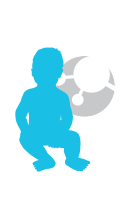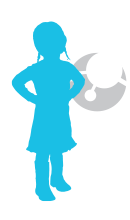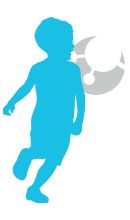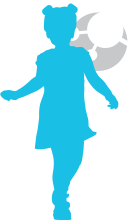Component 1: Scientific Practices and Application
Standard 1.a: Children are increasingly able to engage with the inquiry process by developing questions, planning and carrying out investigations, collecting and analyzing data, generating and sharing findings and ideas, and using and applying new knowledge to solve problems.
By the following age ranges, children typically, for example:
- Express curiosity about the world around them and attend to novel objects, living things, and events in their immediate environment
- Reach for and explore objects within their grasp (e.g., bang a block to make noise; shake keys)
- Move toward favorite objects and adults for play
- Exhibit behaviors and act on objects to get specific results (e.g., cry for attention; kick a mobile to observe its movement and sound; drop a toy to see if an adult will pick it up)
- Communicate interest and willingness to explore using sounds, gestures, signs, and/or facial expressions

- Express their wondering using language, gestures, signs, and facial expressions and show surprise when familiar objects, living things, or events don’t appear or happen as anticipated
- Extend explorations, indoors and out, using all their senses
- Seek out hidden objects to explore (e.g., open cabinets to get pots and pans)
- Use tools for eating, drinking, and playing (e.g., toy tools)
- Begin to explore and identify relationships during their play and in the natural world (e.g., repeatedly push buttons on a phone or other device and listen for the corresponding sounds; anticipate that lightning and thunder will occur together)
- Reach out to trusted adults and children to indicate curiosity and desire to explore (e.g., pull an adult’s hand to go outside)

- Ask simple questions about the objects, materials, living things, and events in their immediate environment
- Investigate a variety of objects during play (e.g., take things apart and put them together; stack and knock down blocks) and vary their actions to observe results (e.g., push a ball gently and hard)
- Use tools for exploration and problem-solving (e.g., spoons and buckets for digging; a stick to get an out-of-reach object) and imitate how others explore and use tools (e.g., a rock as a hammer)
- Apply knowledge about patterns in daily routines to anticipate and make predictions about future events (e.g., get a book to read before naptime, look for boots before going outside on a rainy day)
- Draw the attention of others to what they are doing, observing, and wondering using emerging language, gestures, and/or signs, and imitate how adults respond to exploring natural phenomena (e.g., have confidence when exploring insects or be nervous about getting dirty or wet)

- Communicate a range of questions verbally and non verbally (e.g., ask how a toy works; repeat actions to observe if results are same or different)
- Use all their senses to explore the objects, materials, living things, and events that occur in their immediate environment
- Notice and explore direct cause and effect relationships (e.g., laugh at how their block tower falls when they kick it; place a stick in the path of an ant to observe what happens)
- Compare objects and notice similarities and differences (e.g., sort leaves based on one characteristic, such as color or size)
- With support, record and represent observations in multiple ways (e.g., wiggle their body; make a curvy line on paper to show how a worm moves)
- Make inferences and predictions based on previous experience and relationships they have identified (e.g., cry when they see dark clouds in anticipation of thunder)
- Identify and address mathematical situations that arise in their constructive or exploratory play (e.g., rearrange blocks in different ways to make them balance; try to make a sinking object float)

- Ask and wonder about increasingly complex questions to find out more information or to figure out a solution to a problem (e.g., ask or wonder “Why is the sky blue?” or “How can I make a house for a bug with these sticks?”)
- Use standard and non-standard tools for exploration and data collection (e.g., use a hand lens to look at an insect; use different sized containers for measuring more and less)
- Participate in a range of investigations from more playful (e.g., collaboratively build a bridge for toy cars using a variety of materials) to more structured (e.g., contribute predictions, observations, and ideas to a group sink and float investigation)
- Compare and sort objects based on one property at a time (e.g., sort blocks by color, size, shape, or texture
- With support, record and represent their observations in a variety of ways (e.g., use their body, art and writing materials, or photos to share their observations of a plant; dictate a description of their plant to the teacher)
- Generate explanations about how or why things happen (which may or may not be scientifically correct) based on evidence from their own experience (e.g., heavy things sink because rocks sink; snails will like pizza because I like pizza)

- With support, contribute questions, observations, and ideas to a group discussion on a topic of shared interest (e.g., share questions about what worms eat and ideas for what a worm habitat should include and why) and begin to demonstrate curiosity about the world outside of their immediate environment (e.g., question why animals live in the rainforest or arctic or why severe weather events occur in other locations)
- With support, use a variety of standard and nonstandard tools for data collection and recording (e.g., to measure the height of a tower, count the number of blocks or use a ruler; make rain gauges and windsocks to collect weather data)
- Plan and carry out simple investigations independently or in a small group to answer a cause-and-effect question, test a prediction, or solve a problem (e.g., blow on different objects to find out if or how each one moves; with encouragement, place plants in different conditions and observe, measure, and record their growth)
- Identify increasingly complex relationships in the designed and natural worlds (e.g., explain why a spoon and fork are made differently based on how they are used; describe how a familiar animal’s body parts help it move about and find food)
- Use demonstration, drawings, photos, and models, to record, represent, and communicate their experiences and ideas with others in group discussions
- Increasingly be able to make inferences and construct explanations (which may or may not be scientifically correct) based on a wider range of experiences (e.g., make a drawing that shows where they think rain comes from; talk about what they think a worm’s home looks like and why they think so)

